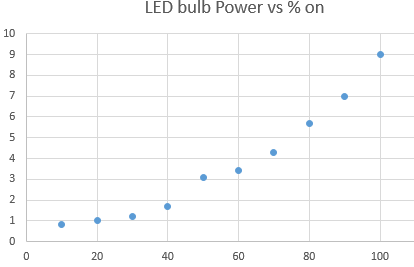Intro
I’ve got my Philips Hue light bulb working with my Amazon Alexa. It’s an older 860 lumens bulb. I also have a voltmeter. So I went through different intensities, recording the power draw for each. The results are in the table below.
| Level (%) | Power (Watts) |
| 100 | 9.0 |
| 90 | 7.0 |
| 80 | 5.7 |
| 70 | 4.3 |
| 60 | 3.4 |
| 50 | 3.1 |
| 40 | 1.7 |
| 30 | 1.2 |
| 20 | 1.0 |
| 10 | 0.9 |
| 5* | 0.8 |
| 0 (off) | 0.3** |

So above 60% or so the relationship looks exponential. 50% seems like an outlier.
*By observation, the lowest lighting you can get from your bulbs is 5%.
**Unexpected finding – smartbulbs are vampire devices
I didn’t originally measure the power draw when “off.” You don’t think to do that. Then I gave it some more thought and had an aha moment – the bulb can only be smart if it is always listening for commands. And that, in turn, must create a power draw when off. A quick measurement and sure enough, confirmed. Though very small – 0.3 watts – it is not nothing. A typical single-family home has over a hundred bulbs. If they were all smartbulbs, it would add up… I believe small draw devices – typically those power adapters for cell phones – are called vampire devices.
Conclusion
So we have a very non-linear relationship here. I probably should plot the current draw as well. But, you definitely can save energy by lowering the intensity – quite a lot. But LED bulbs are drawing very little power anyway, so unless you have bunch of them, why bother?
My second conclusion – a finding I didn’t expect – is that even when off these bulbs are consuming a bit of power. It’s not a lot, 0.3 watts, but it’s something to keep in mind when planning your smartbulb deployment. So, large arrays of smartbulbs? Probably not such a smart idea.